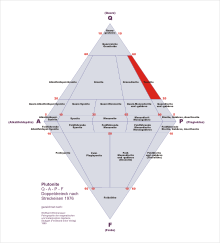Trondhjemit
The Trondhjemite (rarely also Trondheimite ) is an igneous rock from the group of Plutonites . The name was introduced in 1916 by Victor Moritz Goldschmidt after an occurrence near the city of Trondheim and denotes a light variety of the Tonalite .
composition

The main components are quartz and oligoclase from the mixed series of plagioclase . The content of dark components is generally low; Biotite and some hornblende as well as augite are the most common. It is characterized by the content of idiomorphic titanite crystals, which can account for up to 1% of the total rock. Apatite , orthite , magnetite and zirconium can be included as further accessory components .
Education and occurrence
The rock occurs worldwide mainly in the archaic cratons , mostly in a metamorphic form. Trondhjemites form together with tonalites and granodiorites when basaltic crust melts in subduction zones and form the so-called TTG (trondhjemite-tonalite-granodiorite) complexes, which often make up the oldest components of the cratons.
Types of Trondhjemites
literature
- Wolfhard Wimmenauer: Petrography of igneous and metamorphic rocks . Enke, Stuttgart 1985, ISBN 3-432-94671-6 , pp. 92 f .
- Walter Maresch & Olaf Medenbach: Steinbach's natural guide rocks . Mosaik, Munich 1996, ISBN 3-576-10699-5 , p. 50 .
Individual evidence
- ↑ Brief description , accessed on March 1, 2010
- ↑ Kent C. Condie (Ed.): Archean Crustal Evolution . Elsevier, Amsterdam 1994, ISBN 0-444-81621-6 .
- ↑ Mesoarchean tonalite-trondhjemite-granodiorite (TTG) associations (English), accessed on March 1, 2010